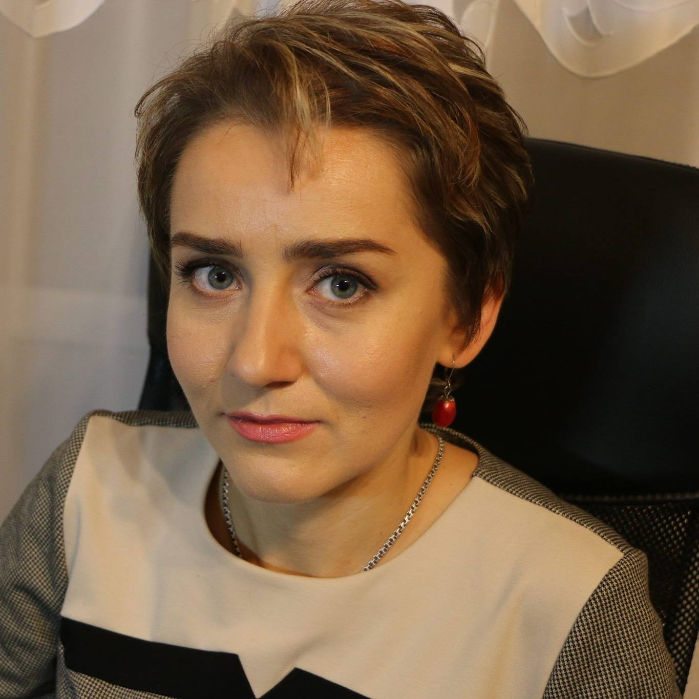
In 2010, during the traditional annual televised conversation with citizens of Russia, the then prime minister Vladimir Putin made the following statement:
Documented in collaboration with Yana Prymachenko, Ph.D., senior researcher Institute of History of Ukraine, National Academy of Science of Ukraine
“If we look at the statistics from the Second World War, then it turns out that the greatest losses in the Great Patriotic War were in the Russian Soviet Federative Socialist Republic. More than 70 per cent of the losses. This means, the war was won, I don’t want to offend anyone, mainly due to the human and industrial resources of the Russian Federation.”
This opening were made by Yana Primachenko, Senior Research Fellow at the Institute of Ukrainian History, National Academy of Science of Ukraine at the webinar "Learing of the past for a better future" co-organized by the Embassy of Ukraine in Norway and us, S2PU.
In 2010, during the traditional annual televised conversation with citizens of Russia, the then prime minister Vladimir Putin made the following statement:
“If we look at the statistics from the Second World War, then it turns out that the greatest losses in the Great Patriotic War were in the RSFSR. More than 70 per cent of the losses. This means, the war was won, I don’t want to offend anyone, mainly due to the human and industrial resources of the Russian Federation.”
Victory over Nazism in the Second World War was not the result of the actions of any one country but rather the joint actions of all participants in the anti-Hitler coalition. Therefore, even the question of a “sovereign victory” by one country is absurd: the combination of each of these countries was important. At the same time, Ukrainians in this remark have been unfairly belittled.
Where did the statement that Russia suffered “70 per cent of the losses in the Great Patriotic War” come from?
The official position of the Kremlin relies on estimates of Russian military historians, according to which between 1941-1945 there were 34.5 million Soviet citizens in the Red Army and Navy. The total losses amounted to 8.6 million out of which 1.4 were Ukrainians (therefore 16 percent of the total military casualties of the USSR or more than all the losses of the USA, Great Britain and Poland combined). In fact, as calculated by independent historians, the military losses of the Soviet armed forces fluctuated between 11-12 million, of which approximately 2.5 million were Ukrainians, thus 21-22 per cent.
However, everything depends on how one counts: by ethnicity or territory.
Russian military experts calculate their figures based on ethnicity and automatically ignore citizens of other nationalities (Russians, Belarussians, Poles, Jews, Germans, Tatars, Moldovans, Armenians, Greeks and others), whose grandfathers and great-grandfathers lived in Ukraine, for whom this land was home. Since Ukraine was always multinational, this approach and the reasons for its use, raise many questions.
The use of this ethnic approach reduced the non-Russian share of losses to 33.7 percent.
According to estimates of Ukrainian researchers, nearly 6 million people from Ukraine fought in the Red Army, thus they made up approximately 23 per cent of the total armed forces of the USSR.
One should not forget about the quality of the indicators either. Among 11.5 million officers and soldiers awarded orders and medals during 1941–1945, about 2.5 million were Ukrainians. For exceptional courage, 2 thousand were awarded the title of the Hero of the Soviet Union. The Hero of the Soviet Union was awarded to Ivan Kozhedub three times and 32 Ukrainians were awarded it twice.
Many Ukrainians were part of the Red Army command, although, since 1941, the number of Ukrainians in the Red Army command had been constantly reducing from 21% to 16,7%. The reason for this was that, in the last period of war, there was a direct ban to enlist in military colleges individuals who lived under occupation. Stalin did not trust those who survived the occupation. In case of Crimean Tartars, this caused a real tragedy of mass deportation.
During the whole war Ukrainians constituted 10 per cent of the Soviet generals. Among them were such prominent Ukrainians as: Semen Tymoshenko, Ivan Chernyakhovsky, Andrii Grechko, Andrii Yeremenko, Kyrylo Moskalenko, PylypZhmachenko.
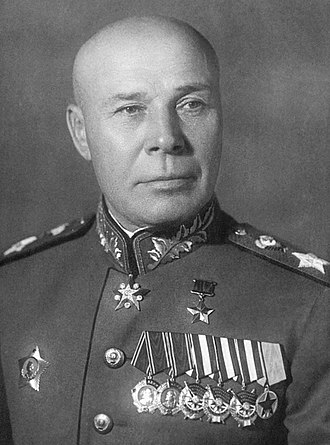 |
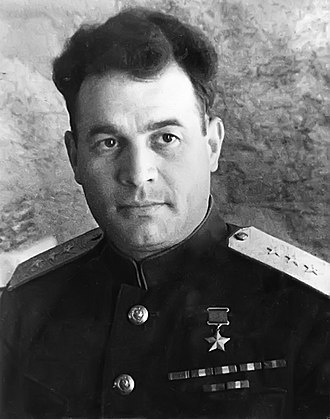 |
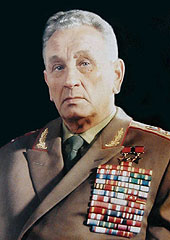 |
||
| Semen Tymoshenko | Ivan Chernyakhovsky | Andrii Grechko | ||
| photo missing so far | 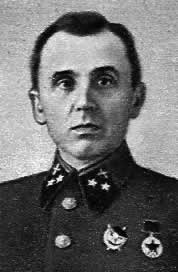 |
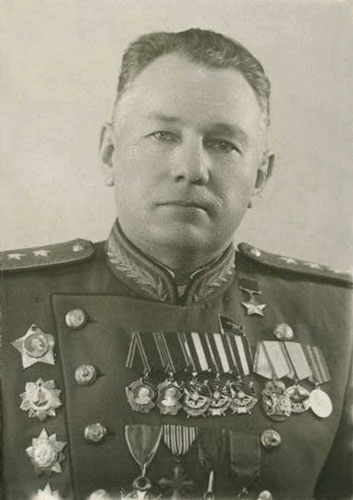 |
||
| Andrii Grechko | Kyrylo Moskalenko | Pylyp Zhmachenko |
On behalf of the USSR, the Japanese Instrument of Surrender was signed by the General Kuzma Derevianko, who was also a Ukrainian.
Until the end of the summer 1941, 3.2 million people were mobilized into the ranks of the Red Army from the territory of Ukraine. Ukrainians made up 50 per cent of the troops in the Southwestern Front. Even in 1942, when the territory of Ukraine was completely occupied, Ukrainians accounted for 8 per cent of the active army, and in 1943 their part increased to 10-11 per cent.
In 1943–1945, 4.5 million people were drafted from Ukraine. Since the second half of 1943, Ukrainians made up from 60 to 80 per cent of the soldiers in the units of the Ukrainian fronts.
The decisive battles on the Soviet-German front are associated with Ukraine. Sixty per cent of the German ground forces were defeated there. In 1943–1944, 12 offensive and 2 defensive operations were carried out on the territory of Ukraine.
Between 1944–1945, the share of ethnic Russians in some armies of the Soviet army was only about 40 per cent, for example, the 60th Army of the 1st Ukrainian Front, which liberated Auschwitz and Krakow, was composed of 36 per cent Russians and 32 per cent Ukrainians.
The Ukrainians also fought against the Nazis in Soviet partisan units.
The group who raised the so called 'Victory Flag' over the Reichstag was headed by the Ukrainian lieutenant Oleksii Berest.
The international recognition of the Ukrainian contribution of the victory over Nazism was granted by UN membership to the Uk.SSR.
As a result of the war, the population of Ukraine decreased by 10.4 million people – from 42.4 million in June 1941 to 32 million in May 1945. Direct losses amounted to 8 million people, of which 5 – 5.2 million civilians.
2.4 million people were taken from the territory of Ukraine to Germany as forced labor.
Between 3.4 and 5.1 million soldiers and officers of the Red Army became prisoners of war (POW). Among 100 thousand POWs and Ostarbeiters transported to Norway, there were 16.5 thousand Ukrainians.
For security purposes, from Ukraine close to 3.5 million citizens of the republic, 550 commercial enterprises, 70 institutions of higher education, 40 theaters and dozens of museums were evacuated to the east of the Soviet Union.
714 cities, 28 thousand villages, 16.5 thousand industrial facilities, 2 million houses were completely or partially destroyed in Ukraine. 10 million people lost their homes. The objects of humanitarian infrastructure were also destroyed, including 18 thousand hospitals, clinics and first-aid posts, about 33 thousand schools, 19 thousand libraries.
Ukraine was one of the major battlefields of the Eastern front. In 1944, the territory of Ukraine became home to 4 out of 10 offensive operation, also known in Soviet historiography as “10 hammer blows” – a series of strategic offensive operations conducted by Soviet armed forces throughout 1944, designed to deal a decisive blow to the German ability to conduct counter offensives and mount military operations along the entire Eastern Front.
It is obvious that the majority of Ukrainians were drafted to the four Ukrainian Fronts, but still Ukrainians made a significant contribution to the liberation of Norway.
Petsamo-Kirkenes offensive operation was conducted by the joint forces of the Karelian Front and the Northern Fleet during 7-29 October 1944. The Red Army of nearly 113,000 men of the Karelian Front, commanded by General Meretskov launched an offensive against the 60,000-strong German XIX Mountain Corps, defending in prepared positions along the Litsa river valley northwest of Murmansk. Assisted by sea, air, and land forces of the Northern Fleet, the Soviet 14th Army defeated the German forces in a three-phased operation that lasted a total of 24 days.
Many Ukrainians, especially ace pilots, fought in the rank of the Red Army in the Soviet Arctic. There were 6 Ukrainians among 30 officers and soldiers of the Karelian front as well as 25 sailors of the Northern Fleet awarded the title of the Hero of the Soviet Union for Petsamo-Kirkenes Operation. In the rank of the Northern Navy Air Force, 6 Ukrainians were decorated as Heroes of the Soviet Union, 2 of them for Petsamo-Kirkenes Operation.
The most vivid example of courage was demonstrated by Fedir Kompaniyets, who received the Golden Star Medal of the Hero of the Soviet Union. On October 25, 1944, under heavy gunfire, Kompaniyets’ detachment made a forced crossing of the gulf Bøkfjorden and provided artillery support to the other detachments of the battalion crossing the gulf. Kompaniyets, together with his detachment, became the first of the Red Army soldiers to enter Kirkenes.
The description of Kompaniyets’ heroic feat was quoted from his recommendation for decoration. It is symbolic that the first man who entered Kirkenes was Ukrainian?
The story of the Ukrainian contribution into the victory over Nazism would not be complete if we do not mention some important facts: For Ukrainians, the war did not begin in June 1941, but rather on 1 September 1939. At the beginning of the Second World War the Polish Army, which totaled 1 million people, included approximately 120,000 ethnic Ukrainian servicemen. During the September campaign in the battles against the Nazis, 8,000 ethnically Ukrainian citizens of Poland were killed.
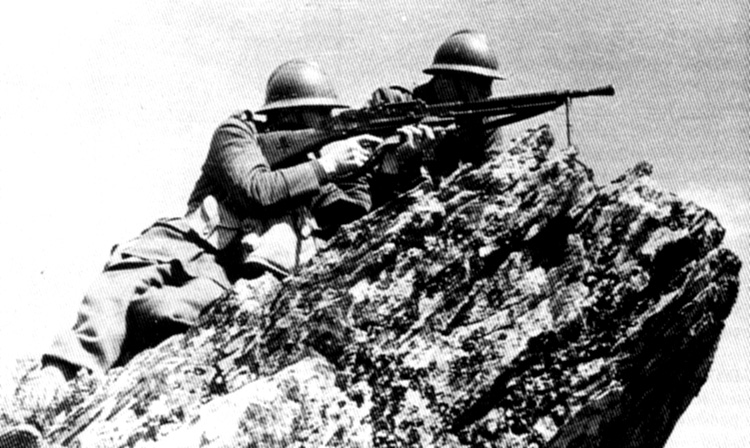
Ukrainian soldiers from the Independent Podhale Brigade during the battles of Narvik 1940. Photo: https://www.warrelics.eu/
Many Ukrainians and Poles from the Ukrainian territory were in the ranks of the Polish Independent Highland Brigade, a Polish military unit created in France in 1939, after the fall of Poland, as part of the Polish Army in France. In May and June 1940 it took part in the Allied campaign in Norway and fought with distinction in the Battle of Narvik.
Ukrainians also fought in the Allied armies. Among the US military, there were 40,000 Americans of Ukrainian descent who participated in Operation Overlord (the landing of Allied troops in Normandy). The number of Ukrainians in the Canadian Army, according to various sources, ranged from 35,000 to 50,000.
Since 1940, 5 thousand Ukrainians fought in the French Foreign Legion.
Thousands of ethnic Ukrainians, former Polish citizens, who were deported to the eastern regions of the USSR after 1939, joined the 2nd Polish Corps under General Wladyslaw Anders. In 1942, the Corps left the territory of the USSR and as part of the British expeditionary troops took part in battles in Italy.
At the eve of the Second World War, Ukrainians were de-facto a stateless nation, whose territory was divided between four states (the Soviet Union, Poland, Czechoslovakia, Romania). Ukrainians also had a large diaspora. So, during World War II Ukrainians were active in different armies and battlefields, even though the majority served in the ranks of the Red Army.
One should always remember that the Red Army is not equal to Russian Army. Ukrainians played a significant role in the victory over Nazism.
And I would like to end my presentation with the iconic picture “East meets West”, where the Ukrainian Oleksandr Silvashko shakes hands with the US soldier William Robertson reconstructing the famous meeting of the Allied Armies on the Elbe river.
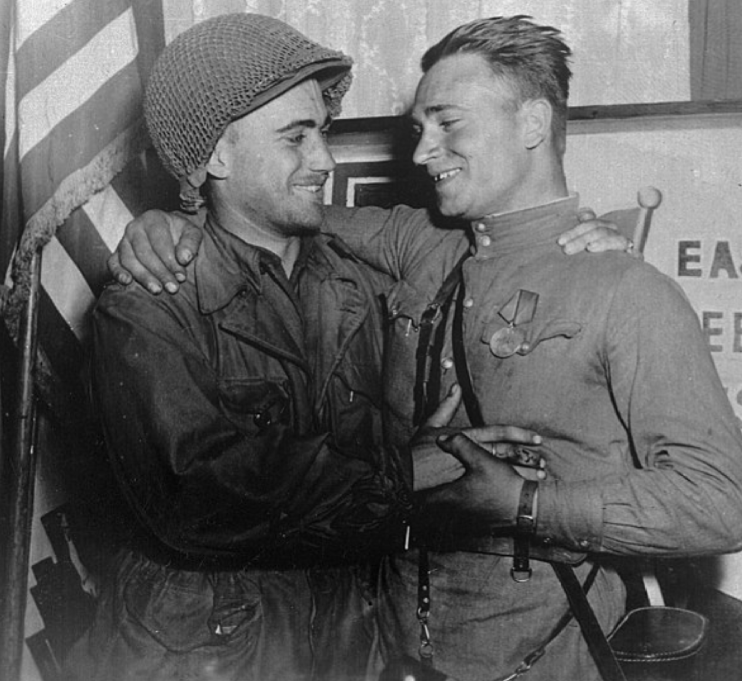
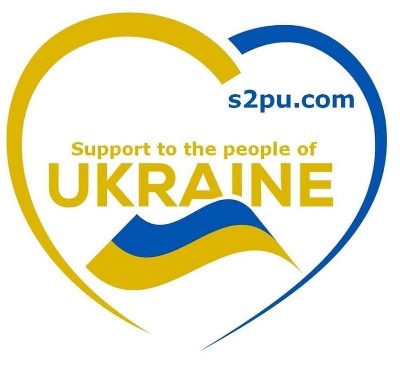
Comments powered by CComment